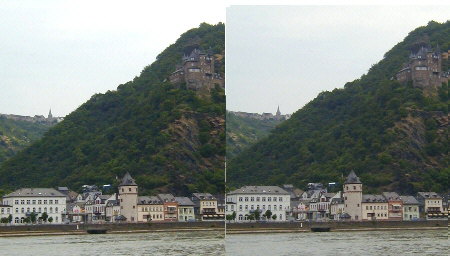This picture shows our original PIC programmer module with a serial port adaptor fitted.
When this is viewed in stereo the increase in clarity is amazing, but you may find it easier to start with the pictures of Colchester further down on this page.
|
 |
This is the same circuit photographed from the usual viewpoint.
It is quite difficult to take close up stereo pictures using one camera. It is best to mount the camera on a tripod and move the tripod a few inches between the frames, turning the camera slightly to keep the same area in view.
|
 |
This picture taken in Castle Park Colchester has little interest until the 3 dimensional qualities are seen. When seen in just 2 dimensions the trees blend together and the true qualities of the picture are lost.
|
 |
This picture taken further down in the same area is uninspiring until seen in 3D.
If you are not able to adjust your eyes to view these pictures use a piece of cardboard about 18 inches long by 6 inches wide to split the screen into two areas so that each eye can only see one image.
Place the short edge of the cardboard mid way between the pictures and bring your nose up to the other edge.
|
 |
For this picture I have exaggerated the 3D effect by moving much more than the distance between two eyes. Notice that even the houses in the background have a significant 3D effect.
This picture has a problem which often crops up when one camera is used to take the stereo photographs. The people in the picture have moved in between the two frames. In this picture it is not too important. I also had this problem with the first picture on this page and in that case I needed to cut and paste the images to cover up the main problem area.
|
 |
| This picture of St Botolphs Priory in Colchester has great depth when viewed in 3 dimensions. Study the stone work in 2 dimensions first, then change over to stereo vision and the difference is dramatic.
|
 |
| This was taken across the Rhein in Germany. I moved much more than 3 inches to exaggerate the 3D effect.
|
 |
Germany almost at the Austrian border. If you feel strange looking at the clouds this is because they have moved in between the two frames.
|
 |







